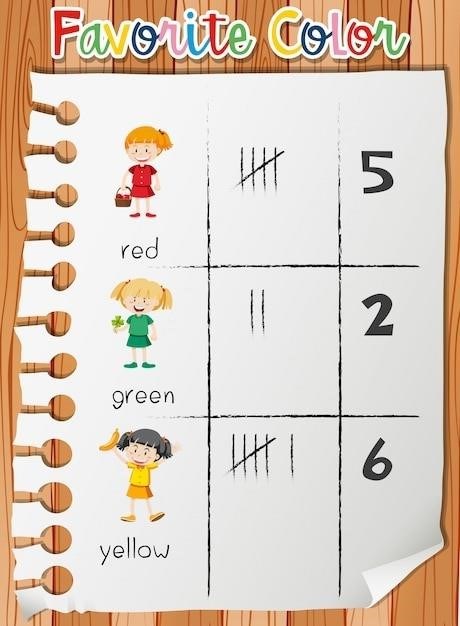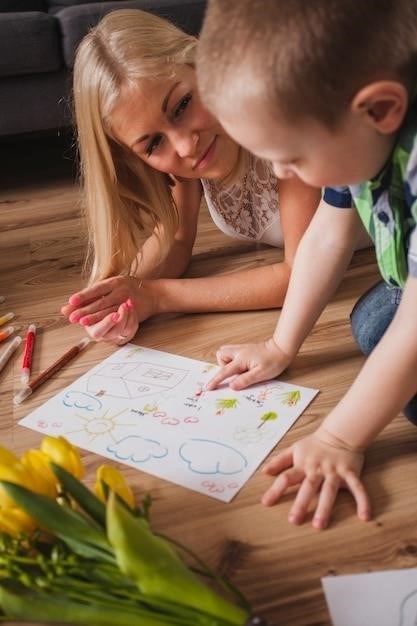Language Development Milestones for 3-5 Year Olds
Three-to-five-year-olds rapidly expand their vocabulary‚ mastering complex sentence structures. They articulate thoughts and ideas clearly‚ follow instructions readily‚ and ask increasingly sophisticated questions‚ demonstrating significant language development progress.
Understanding Vocabulary and Sentence Structure
During the crucial 3-5 year age range‚ children’s vocabulary explodes. They move from simple sentences to complex ones‚ incorporating conjunctions and prepositions. Activities focusing on expanding vocabulary are key. Reading aloud diverse books introduces new words and sentence structures. Labeling objects around the house helps children connect words to their referents. Playing word games like “I Spy” or rhyming games reinforces vocabulary acquisition and improves understanding of sounds and their relationships within words. Engaging in storytelling together allows children to experiment with sentence construction and narrative sequencing. Focusing on descriptive words helps children paint vivid pictures with their language‚ building their expressive skills. Simple activities such as describing what they see or hear during daily routines help build their descriptive language skills and understanding of vocabulary. By actively engaging in these activities‚ children build a strong foundation for future communication success.
Expressing Thoughts and Ideas
Children aged 3-5 are developing their ability to clearly communicate their thoughts and ideas. Encouraging this involves creating opportunities for open-ended conversation. Asking open-ended questions‚ such as “What was your favorite part of the day?” or “Tell me about your drawing‚” prompts detailed responses. Role-playing games‚ where children take on different characters and scenarios‚ encourage creative expression and using language to build narratives. Storytelling‚ either through creating their own tales or retelling familiar stories‚ helps them organize their thoughts and improve narrative structure. Providing opportunities for children to explain their actions and choices helps them develop reasoning skills and articulate their perspective clearly. Building with blocks or other construction toys and then narrating what they’ve built encourages them to explain their thought processes and the steps they took. Engaging in these activities helps children develop confidence in expressing themselves and effectively conveying their ideas to others‚ fostering their language skills.
Following Instructions and Asking Questions
At ages 3-5‚ children’s ability to follow instructions and ask questions significantly improves. Start with simple‚ one-step instructions‚ gradually increasing complexity as their skills develop. Use clear and concise language‚ avoiding ambiguity. For example‚ instead of “Clean your room‚” try “Put your toys in the toy box.” Games involving sequential steps‚ like building a tower or following a recipe for simple snacks‚ are excellent for practicing following multi-step instructions. Encourage questions by showing genuine interest in their inquiries. Respond thoughtfully and expand on their questions‚ providing further explanation and information. Reading books together and discussing the story also helps build comprehension and encourages asking questions about the plot‚ characters‚ or illustrations. Open-ended play activities‚ where children can explore and experiment‚ naturally lead to questions as they discover new things. By actively responding to their questions and offering guidance‚ you create a supportive environment that fosters their language development and curiosity.

Fun and Engaging Activities
Make language learning enjoyable! Incorporate interactive games‚ songs‚ and storytelling to boost vocabulary and communication skills in preschoolers.
Reading Books Aloud and Discussing Stories
Reading aloud is a cornerstone of language development for 3- to 5-year-olds. Select age-appropriate books with vibrant illustrations and engaging narratives. As you read‚ use expressive tones and varied pacing to keep your child captivated. Pause frequently to ask questions‚ prompting them to predict what might happen next or describe the characters’ emotions. Encourage them to retell the story in their own words‚ fostering narrative skills and expanding their vocabulary. Discuss the illustrations‚ asking them to identify objects‚ colors‚ and actions. This interactive approach transforms reading time into a collaborative language-building experience. Don’t hesitate to introduce new vocabulary words‚ explaining their meanings within the context of the story. By actively engaging with the book’s content‚ children develop comprehension‚ enhance their vocabulary‚ and improve their communication skills; Remember to make it fun and adjust the activity to your child’s interests and attention span for optimal learning and enjoyment. Regular reading sessions create a positive association with books and lay the foundation for a lifelong love of reading. The more they engage‚ the better their language skills will become.
Singing Songs and Rhymes
Singing songs and reciting rhymes are incredibly effective for boosting language development in 3- to 5-year-olds. The rhythmic nature of songs and rhymes helps children develop phonological awareness—the ability to hear and manipulate the sounds of language. This is crucial for reading and spelling skills later on. Familiar songs and rhymes provide repetitive exposure to vocabulary and sentence structures‚ aiding in memorization and language acquisition. Engage your child by singing together‚ encouraging them to join in‚ even if they only know a few words. Use actions and gestures to make the songs more interactive and engaging. Introduce new songs and rhymes regularly to keep things fresh and exciting. You can also adapt familiar songs‚ substituting words to relate to your child’s experiences or interests. This personalized approach enhances their understanding and enjoyment‚ making the learning process more meaningful. Focus on pronunciation and encourage your child to sing along clearly‚ paying attention to each word. The combination of rhythm‚ repetition‚ and interactive engagement makes singing and rhymes a fun and effective language-learning tool.
Playing Word Games
Word games are a fantastic way to engage preschoolers in language development activities. Simple games like “I Spy” enhance vocabulary and descriptive skills as children identify objects and use descriptive adjectives. Rhyming games‚ such as finding words that rhyme with a given word‚ improve phonological awareness and vocabulary. Categories games challenge children to think of words belonging to specific categories (e.g.‚ animals‚ colors‚ fruits)‚ expanding their knowledge and word retrieval skills. “Twenty Questions” sharpens their questioning and problem-solving abilities. Adapt games to your child’s level‚ making them easier or more challenging as needed. Make it interactive and fun by using props or visuals. Praise their efforts and participation‚ even if they don’t get all the answers right. Remember to focus on the enjoyment of the game‚ fostering a positive learning environment. By incorporating these strategies‚ you can transform ordinary playtime into valuable language-building exercises‚ supporting the development of essential communication skills.

Creative and Imaginative Play
Encouraging imaginative play‚ such as role-playing and storytelling‚ significantly boosts language development in preschoolers‚ fostering creativity and communication skills.
Role-Playing and Pretend Play
Role-playing and pretend play are invaluable tools for fostering language development in 3-to-5-year-olds. These activities provide a rich context for children to practice and expand their vocabulary‚ experiment with different communication styles‚ and develop narrative skills. By engaging in imaginative scenarios‚ children naturally incorporate new words and phrases into their conversations‚ strengthening their expressive language abilities. The act of creating stories and characters within their play encourages the development of complex sentence structures and improved fluency. Pretend play also helps children understand social interactions and develop their communication skills in realistic contexts. Whether they’re playing doctor‚ shopkeeper‚ or superhero‚ children learn to negotiate‚ compromise‚ and express their needs and desires effectively. The open-ended nature of pretend play allows for endless possibilities‚ making it a truly engaging and effective way to promote language growth.
Storytelling and Creative Writing
Encouraging storytelling and creative writing significantly boosts language development in 3-to-5-year-olds. These activities nurture vocabulary expansion‚ enhance narrative skills‚ and refine sentence structure. Children can begin by retelling familiar stories or creating their own simple narratives‚ gradually building complexity over time. Providing prompts‚ such as pictures or objects‚ can inspire creativity and provide a starting point for storytelling. The process of crafting a story‚ even a simple one‚ involves selecting appropriate vocabulary‚ sequencing events logically‚ and using descriptive language to paint a vivid picture. This helps children develop their expressive language skills and strengthens their ability to communicate ideas effectively. Creative writing‚ even in its earliest forms‚ such as drawing and dictating stories‚ encourages children to explore language in a playful and engaging way. As they progress‚ they can begin to write simple sentences and paragraphs‚ further developing their literacy skills alongside their spoken language. The act of sharing their stories with others boosts confidence and reinforces the importance of clear communication.
Using Puppets and Toys
Puppets and toys offer dynamic tools for fostering language development in preschoolers. Children engage in imaginative play‚ spontaneously creating narratives and dialogues‚ significantly enhancing their communication skills. Using puppets‚ they can assume different roles and perspectives‚ enriching vocabulary and promoting fluency. Simple storytelling with puppets can be adapted to various themes‚ introducing new vocabulary related to characters‚ settings‚ and events. Toys‚ particularly those that encourage interaction‚ facilitate language practice. Building blocks‚ for instance‚ allow for collaborative storytelling‚ where children describe their creations and engage in discussions about their designs. Pretend play with dolls or action figures prompts role-playing‚ where children mimic adult behaviors and conversations‚ naturally expanding their vocabulary and sentence structures. This interactive play setting offers a low-pressure environment for language experimentation‚ allowing children to confidently practice new words and phrases without fear of judgment. The playful nature of these activities ensures that language learning remains enjoyable and motivating‚ crucial for sustained progress in language acquisition.
Practical Application of Language Skills
Everyday conversations and interactions are vital. Children practice newly acquired vocabulary and grammar in real-world settings‚ solidifying their language skills.
Everyday Conversations and Interactions
Integrating language learning into daily routines is key. Mealtimes offer opportunities to discuss foods‚ their colors‚ textures‚ and tastes. Engage children in conversations about their day‚ prompting them to use descriptive words. When performing household chores‚ narrate the steps involved‚ enriching their vocabulary. Trips to the park provide chances to describe the surroundings‚ animals‚ and other children. In the car‚ play simple word games like “I Spy” or sing songs together. Bedtime stories become occasions to explore new words and concepts. Encourage storytelling by asking open-ended questions‚ such as‚ “What happened next?” These casual interactions create a natural context for language practice‚ subtly expanding their vocabulary and improving communication skills. Remember to actively listen and respond to their attempts at conversation‚ even if it’s just babbling‚ showing your engagement and encouraging them to continue communicating. By embedding language learning within the fabric of their daily lives‚ you foster a love for communication and strengthen their abilities organically. This approach seamlessly blends education with everyday life.
